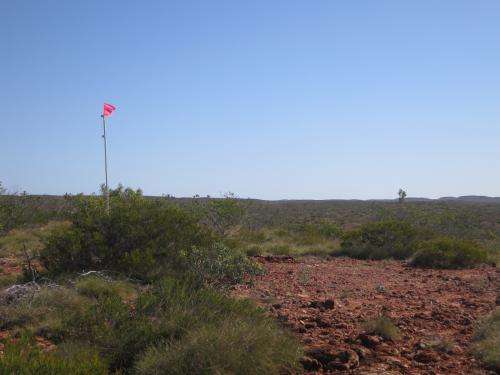SST to monitor objects 22,000 miles above Earth

As satellites become more common, they face growing risk of colliding with space debris and even each other. The U.S. Department of Defense has thus made space situational awareness a top priority to maintain communication, Earth observation and other critical capabilities upon which military, civilian and commercial functions rely. Traditional telescope technology, however, has difficulty finding and tracking small objects—such as debris and satellites—across wide tracks of sky, especially at the increasingly crowded geosynchronous orbits roughly 22,000 miles above the Earth's surface.
To help overcome these challenges, DARPA has developed the Space Surveillance Telescope (SST). Through its unique combination of several novel technologies, the SST program seeks to enable much faster discovery and tracking of previously unseen, hard-to-find small objects in geosynchronous orbits. The SST will soon move from its current mountaintop location in New Mexico, where the system underwent operational testing and evaluation, to Australia, where it will provide key space situational awareness from the southern hemisphere—an area of the geosynchronous belt that is still largely unexplored.
U.S. Secretary of Defense Chuck Hagel and Australian Defense Minister David Johnston signed a Memorandum of Understanding on Nov. 20, 2013, in Washington, D.C., approving the relocation of the SST from White Sands Missile Range, N.M., to the Harold E. Holt Naval Communication Station in Exmouth, Western Australia. Under this agreement, the United States (through DARPA) is responsible for delivering the SST to Australia. The Australian government will build an enclosure for the telescope and operate it. The U.S. Air Force will own the telescope and the two countries will share operations and maintenance costs. The relocation process is planned to start next year and the telescope is expected to resume operations sometime in 2016.
"This is a significant initiative under the Australia-U.S. Space Situational Awareness Partnership, and will provide an important capability for both Australia and the U.S.," Johnston said in an official statement.
"This telescope provides highly accurate detection, tracking, and identification of deep space objects, and will further strengthen our existing space cooperation," Hagel said, according to a transcript from the U.S. State Department. "All of these steps are helping strengthen our alliance as we continue to work together to face the challenges and opportunities of this new century."
From its new home, the Australian operators of the SST will feed the information the system captures into the Space Surveillance Network (SSN), a U.S. Air Force system charged with cataloguing and observing space objects to identify potential near-term collisions with space assets. The SSN is a global network of radar and optical telescopes that provide data to spacefaring countries around the world. The SST will also continue to provide NASA and the scientific community with surveillance data on transient events such as supernovae, as well as potentially hazardous near-earth asteroids.
Started in 2002, the SST achieved first light and acquired its first images in February 2011. DARPA and the Air Force have conducted numerous successful demonstrations of the system from 2011 to 2013.
The SST offers unprecedented rapid search of small objects in space thanks to its innovative Mersenne-Schmidt design and its curved charge coupled device (CCD) imaging technology, the first of its kind. The combination also enables the SST to be much more compact than traditional ground-based telescopes of similar capability. The telescope's mount uses advanced servo-control technology, making the SST one of the quickest and most agile telescopes of its size ever built.
The SST's capabilities are equally impressive: It can search an area larger than the continental United States or Australia in seconds and survey the entire geosynchronous belt within its field of view multiple times in one night, an order of magnitude faster than traditional telescopes. Additionally, the SST is ten times more sensitive than current state-of-the-art systems, enabling it to find and track much smaller, dimmer and more transient objects than its predecessors can.
"The SST has moved space situational awareness from looking through a drinking straw to a windshield view, where we can see 10,000 objects the size of a softball at a time—any of which could put satellites at risk," said Lt. Col. Travis Blake, DARPA program manager. "This program has already helped revolutionize ground-based space surveillance technology. From its new location, it could greatly expand the capability of the United States, Australia and other nations to keep their space assets safe."
Provided by DARPA




















